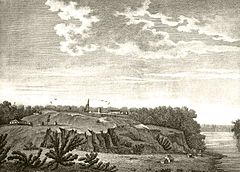
Back Natchez-Aufstand German Révolte des Natchez French ナチェズの虐殺 Japanese Powstanie Naczezów (1729–1731) Polish Восстание натчезов Russian Повстання натчез Ukrainian Thảm sát Natchez VI
The Natchez revolt, or the Natchez massacre, was an attack by the Natchez Native American people on French colonists near present-day Natchez, Mississippi, on November 28, 1729. The Natchez and French had lived alongside each other in the Louisiana colony for more than a decade prior to the incident, mostly conducting peaceful trade and occasionally intermarrying. After a period of deteriorating relations and warring, Natchez leaders were provoked to revolt when the French colonial commandant, Sieur de Chépart, demanded land from a Natchez village for his own plantation near Fort Rosalie. The Natchez plotted their attack over several days and managed to conceal their plans from most of the French; colonists who overheard and warned Chépart of an attack were considered untruthful and were punished. In a coordinated attack on the fort and the homesteads, the Natchez killed almost all of the Frenchmen, while sparing most of the women and enslaved Africans. Approximately 230 colonists were killed overall, and the fort and homes were burned to the ground.
When the French in New Orleans, the colonial capital, heard the news of the massacre, they feared a general Indian uprising and were concerned that the Natchez might have conspired with other tribes. They first responded by ordering a massacre of the Chaouacha people – who had played no role in the revolt – and wiped out their entire village. The French and their Choctaw allies then retaliated against the Natchez villages, capturing hundreds of Natchez and selling them into slavery, although many managed to escape to the north and take refuge among the Chickasaw people. The Natchez waged low-intensity warfare against the French over the following years, but retaliatory expeditions against Natchez refugees among the Chickasaw in 1730 and 1731 forced them to move on and live as refugees among the Creek and Cherokee tribes. By 1741, the Natchez had established a town in the northern parts of the Upper Creek Nation. There, with permission from the Abihka, they reconstituted their town and were signatories in the 1790 Treaty of New York and the 1796 Treaty of Colerain. They remain a constituent tribe of the Muscogee (Creek) Nation.
The attack on Fort Rosalie destroyed some of the Louisiana colony's most productive farms and endangered shipments of food and trade goods on the Mississippi River. As a result, the French state returned control of Louisiana from the Company of the Indies to the crown in 1731, as the company had been having trouble running the colony. Louisiana governor Étienne Perier was held responsible for the massacre and its aftermath, and he was recalled to France in 1732.

